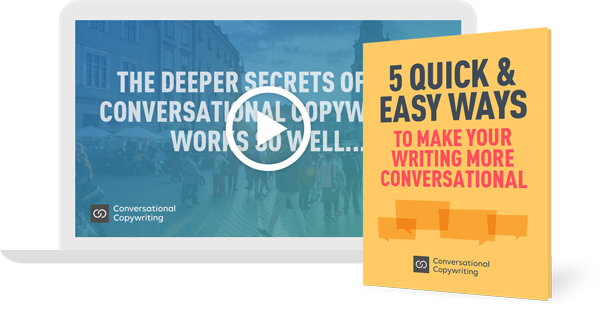
If you’re going to pitch your clients or partners on the benefits of conversational copywriting, it will help if you have some solid arguments lined up and ready to go.
Fortunately, the conversational approach is rich with key points of difference and advantage.
This is particularly true when you’re competing with copywriters or marketers who are still hanging onto the traditional, broadcast approach to copywriting.
The old-school approach may still work for old media like TV and radio, but it has no place online.
Let’s explore just 5 of the ways you can power up your pitch when you’re talking about conversational copywriting.
Pitch #1: Conversational copywriting drives more sales by engaging your audience at an emotional level.
When the UK’s Institute of Practitioners in Advertising analyzed the effectiveness of ads taken from a large database of award-winning campaigns, they found that the ads with emotional content performed TWICE as well as those that relied on rational content.
In other words, as every copywriter knows, you should always appeal to your audience’s emotions.
And one of the simplest ways to connect with people emotionally is through a conversational voice.
People feel mistrustful of the formal marketing voice and are unlikely to open up emotionally to your sales pitch.
But when you talk in a more open and conversational tone, your voice feels more human, believable and real.
That’s how you forge emotional connections and pave the way for a sale.
Pitch #2: Conversational copywriting is super-persuasive because it leverages the natural enthusiasm of spoken language.
If you think formal sales copywriting is the only way to make a sale, you’ve clearly never been to a political rally or to your local house of worship.
The spoken word carries massive power. History’s greatest orators and preachers have changed the world with their speeches… with the spoken word.
Closer to home, if you have a teenager in the house, you’ve doubtless heard his or her impassioned pleas for permission to stay out late on a Friday night.
Conversational copywriting draws from the structure of spoken language, and borrows from the persuasive vocabulary used by orators, preachers and teenager alike.
Get it right and conversational copywriting can be powerfully persuasive.
Pitch #3: Conversational copywriting makes the sale without being adversarial or relying on brute force sales techniques.
When using this approach, you’ll be comparing conversational copywriting with the adversarial, in-you-face approach to sales made notorious by used car salesmen and late-night TV infomercial hosts.
When you frame it like this, you’re exaggerating. Not many marketers push that hard.
But it’s still a valid comparison, because the entire old-school, broadcast approach to copywriting is now outdated.
This is particularly true when you’re marketing online. The web is by definition a social and conversational medium.
Consumers are in conversation with their friends through social media all the time. They are keenly aware of the difference between a conversational voice and an overly promotional voice.
And they have plenty of reasons to mistrust the overly promotional voice.
If you want to engage those people, earn their trust and close the sale, you’re better off taking the more natural, conversational approach.
Pitch #4: Conversational copywriting is disarming and invites people to lower their defenses.
We are all bombarded by thousands of advertising messages every single day. And we’ve become pretty good at simply ignoring most of them.
But when a sales pitch gets past our standard filters, we respond in one of two ways.
Both responses take place at a neurological level.
There’s a whole industry out there that focuses on neurological marketing. Using a variety of approaches, including MRI machines, they track our responses to promotional pitches.
And when a sales message comes over as too pushy and insistent, a part of the brain called the amygdala lights up like a Christmas tree.
When the amygdala lights up, it’s game over for the advertiser. The amygdala is the “fight or flight” part of our brain. Very old and very primitive. It will protect you from sabre-toothed tigers by making you run for your life. And it will protect you from loud advertisers by simply “closing your mind” to the noise.
This happens at a neurological level. We actively switch off inbound messages that are too loud and adversarial.
But using the same MRI machines, researchers have shown that a quieter, more conversational approach has a quite different effect. The amygdala stays quiet and the prefrontal cortex lights up.
The prefrontal cortex is where we take higher-level decisions.
Put simply, when your promotional message leaves the amygdala alone, you’re essentially disarming your reader and making her feel safe enough to listen to what you have to say.
This is a huge deal, and a powerful argument for the conversational approach to marketing.
Pitch #5: Conversational copywriting lets you reach out to your audience more often without burning through their trust.
In the words of Niall FitzGerald, former Chairman and CEO of Unilever…
“You can have all the facts and figures, all the supporting evidence, all the endorsements that you want, but if at the end of the day you don’t command trust, you won’t get anywhere.”
Trust is everything. Without trust people won’t buy from you. They definitely won’t have anything positive to say about you to their friends or colleagues.
Without trust, your prospects will stop opening your emails. And they’ll disengage from your social media channels.
So yes, trust is everything.
That’s why, in the online world in particular, you need to stop shouting at your audience and start engaging with them in a more open and transparent way.
Openness and transparency build trust. It’s that simple.
Mix and match to suit the situation…
I hope you find these 5 pitch approaches helpful.
Maybe you’re pitching a prospective client.
Or perhaps you just want to persuade a colleague to lighted up on the traditional, blunt-force approach to marketing online.
Either way, you can mix and match these ideas to best suit your situation.
Like I said at the beginning, you’ll find all 5 pitch approaches at their most compelling when the freelancers or marketers you’re competing with are still hanging onto the traditional, broadcast approach to copywriting.
And, of course, you’ll be able to make your case a lot more forcefully once you’ve completed the Conversational Copywriting course itself…

I have worked for some large corporations and smaller B2B companies as a digital copywriter. I have found it harder to convince the project stakeholders that conversational tone is still a powerful way to go when attracting prospects to buy for business. Even some startup clients launching online software business still want the formal business language approach to driving traffic to the website. And pay attention to traffic visitors stats on the website first. I am a firm believer that conversational tone is the way to go with inbound messaging, as most prospects still have a heart and the messaging driving them to become a lead will kick off the conversation with dedicated sales team followup. I’d like to hear more about how to use conversational tone in B2B messages, and how powerful it can be to get the prospects on their way with the customer journey that so many content strategists plan and produce for. It still holds true–if you build it, whether a slick website or valuable content, they will not come until you get the word out to start the online conversation. I’ve heard content experts say “Content is King.” My motto is “Content is King; but context is Queen.” When, where and how they encounter the messaging to get to the juicy content make all the difference.
Nick, Thank You for sharing 5 Ways to pitch your services as a conversational copywriter. It makes sense that TRUST with conversation is a key component to engaging your customer.
I appreciate the feedback. And yes, it ultimately boils down to trust. If I don’t trust you, I won’t buy from you.